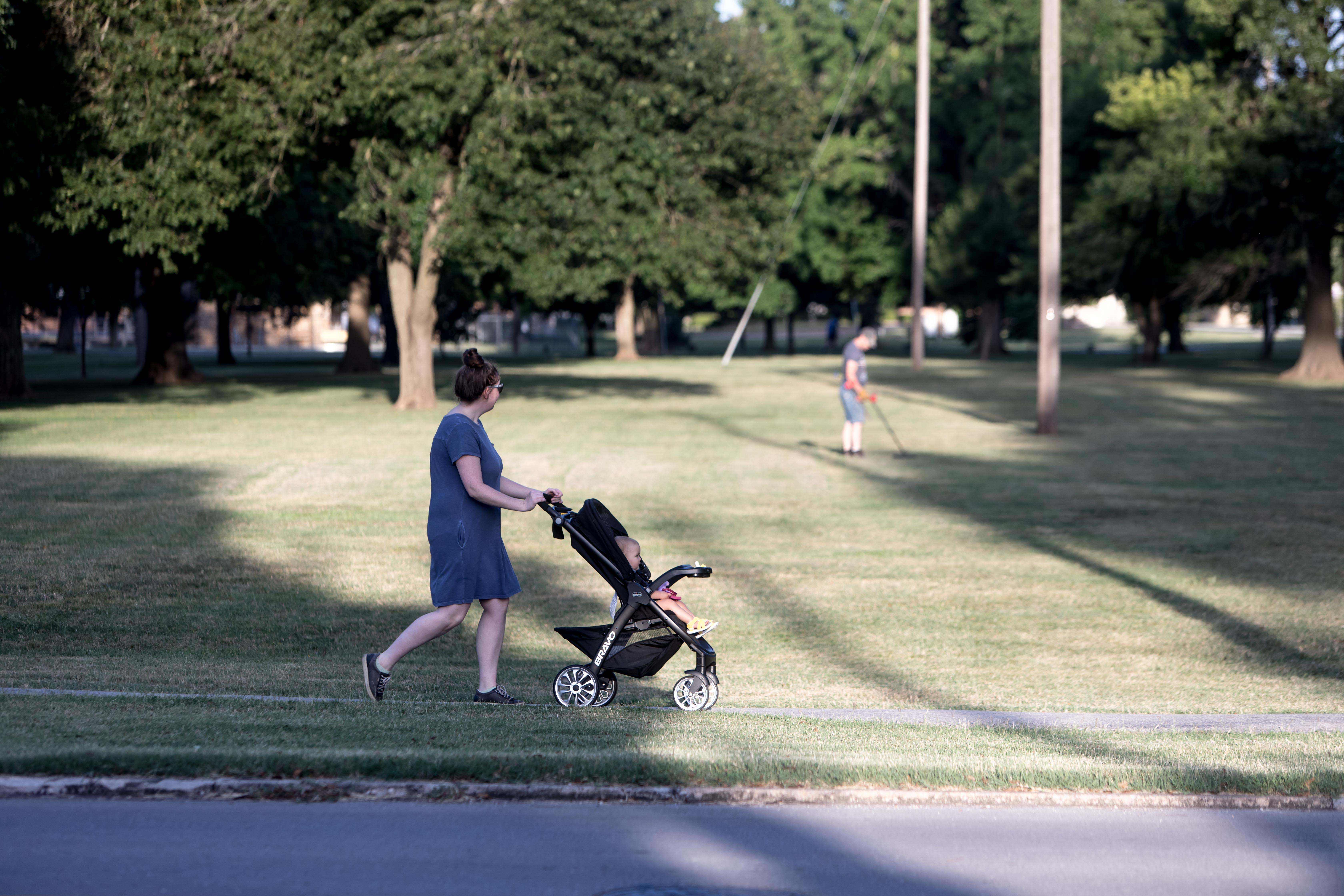Second in a series on the Child Care Crisis in Springfield and Greene County.
Why care? A severe shortage of quality child care slots — and parents confused about where to turn for information — puts some families at risk. It also adds to workforce shortages as parents scramble to find affordable care.
At a time when most of Greene County’s licensed child care centers are operating at reduced capacity and have empty classrooms due to staffing shortages, Mighty Marvels Adventure Academy’s classrooms are all open and the center is at its capacity with 82 children.
But that’s not because the center is fully staffed. Not even close, said director Leota Ledford.
“Our people are working 50 hours a week,” Ledford said, noting the ‘Now Hiring’ sign in front of the building.
It’s a commonplace sign at child care centers across Springfield, Greene County, and the nation. Experts say the pandemic amplified an already broken business model for the child care industry, which offers low pay and minimal benefits to many workers.
In the early days of the pandemic, the number of slots for children in licensed child care centers in Greene County dropped by one-third, or nearly 3,600. All but 700 of those slots have reopened, but most child care centers in Greene County continue to operate at one-half to two-thirds of capacity due to staff shortages.
To keep those Mighty Marvels classrooms open and properly staffed to meet the state’s strict teacher-to-child ratio requirements, Ledford said she has to constantly move teachers and children around.
On the recent day the Hauxeda visited, six kids were on vacation and two were absent. That allowed Ledford to shuffle kids and teachers to keep all classrooms in compliance with the required student/teacher ratios. Plus, she was able to send a staffer — one who was already at 40 hours for the week — home early.
“We have to do some magic,” Ledford said. “It’s just a big numbers game. Every single morning, every single day, I’m already prepping the night before.”

This series is published in coordination with KY3 News. Watch the evening newscasts all this week on the Ozarks CW and KY3 News, or go to their website for related coverage.
Mighty Marvels, 536 E. Cherokee St., pays a bit more than minimum wage, starting out at $12 an hour. That goes up depending on experience and education, Ledford said.
“We pay more now than we ever have,” she said. “I mean, fast food restaurants pay $15, $16, $17 an hour and that is awesome. But you also have to work nights and weekends. We don’t.”
Still, Ledford acknowledges staffing issues plague the child care industry, which unlike other industries cannot easily pass the cost of wage increases on to its customers.
Those customers are parents who are already struggling to pay current tuition rates.
Child care providers and parents are ‘tapped out’

“This business model isn’t effective,” said Robin Phillips, CEO of Child Care Aware of Missouri. “The child care provider community is tapped out. The parents are tapped out.”
Child Care Aware of Missouri is a nonprofit agency based in St. Louis that has served as the state’s leading source for referrals, professional development, and child care information for more than a decade.
As someone who has been in the child care industry for more than two decades, Phillips said the industry has been in crisis long before the pandemic hit.
“This is a national crisis, and it always has been. COVID exposed it all,” she said. “Throw in the Great Resignation and all these competitive wages, and child care programs just cannot compete. Because the only way they can keep teachers is to raise wages, which then falls on the backs of parents.”
Because people couldn’t work if they didn’t have child care, the pandemic caused the loss of so many child care spots that even the empty nesters and people who don’t have kids had to take notice, she said.
“They think, ah this isn’t my problem,” Phillips said. “But the thing is, we all work with people or we manage people or we run a company of employees that have different life challenges. And oftentimes child care is a big part of that challenge.”
Some potential solutions require employers to get involved, Phillips said, whether that’s offering to subsidize child care for employees or maybe having a contract with existing child care providers that have open spots for their employees.
“It cannot just be employers anymore expecting their staff to just figure it out,” she said.
Phillips was recently interviewed by Sally Payne, Springfield’s director of Workforce Development, about the child care crisis for Payne’s podcast, Workforce Vibe.
“There’s a lot of attention coming out for Springfield,” Phillips said in that podcast. “Keep the conversations happening. Invite some child care providers into the conversations from your community. Learn from them. Understand them. …
“If we aren’t listening to our child care provider community,” she added, “we’re not going to have an inclusive approach to trying to figure out some solutions.”
Low pay makes hiring difficult: Classrooms sit empty, waitlists stay long
Payne also spoke with Community Foundation of the Ozarks’ CEO Brian Fogle about these issues on a recent Workforce Vibe.
In that podcast, Payne and Fogle talked about the very low pay most child care workers earn. According to the U.S. Bureau of Labor Statistics, the national average is around $21,000 a year. The “mean” wage is around $24,000.
During their conversation, Fogle wondered if “our priorities as a society” are somewhat off.
“(Child care workers) are taking care of our most precious resource,” Fogle said. “That’s our children. And you are making $12.50 an hour. Or you can go work for a fast food place and make $16 to $18 an hour. And I’m not diminishing the value of working at a fast food place. But we seem to have that backwards in my mind.”
Jessica Phillips, director at Messiah Lighthouse Child and Family Development Center in Springfield, acknowledged that the church-operated center is unable to pay employees much more than minimum wage.
There are currently more than 60 children and babies on Phillips’ waiting list for a spot at Messiah Lighthouse, 925 E Seminole St. Yet, two of the five classrooms at the center sit empty due to staffing shortages.
“We can hold up to 40 (kids), but right now we’re at about 26,” Phillips said. “In order for us to open all our classrooms, we would need four or five teachers.”
When Phillips was first interviewed for this story in early June, starting pay at Messiah Lighthouse was minimum wage. A few weeks later, the center’s board approved raising that to $13 an hour.
As far as benefits, Messiah Lighthouse offers vision and dental insurance but no sort of health coverage.
“We’ve put ads out there on Indeed, and we haven’t had any hits,” Phillips said. “You can go to McDonald’s and make way more than here, and they have way better benefits as well.

Phillips said she lost an employee just a couple of weeks ago who had only been at Messiah Lighthouse for a month. The woman was offered another position that paid $16 an hour with benefits.
“She just couldn’t stay here when she had an offer like that,” Phillips said. “Most of the time, people are sad to go because they love the kids. They love the job. But it’s hard work, and there’s not enough pay for it.”
Ledford, with Mighty Marvels, said that “Now Hiring” sign has been posted in the center’s front yard since it opened in 2019.
“Even getting people in the door to do an application, to do an interview is tough,” Ledford said.
As with most child care providers, benefits are slim at Mighty Marvels. The center offers employees Aflac, which is essentially a supplemental insurance plan meant to fill in gaps for a person’s primary insurance.
“Health insurance is a no,” Ledford said. “We can’t afford it.”

Other perks include paid vacation after the employees have been there a year, paid holidays off and a paid day off for their birthday, Ledford said.
While she couldn’t say enough good things about the staff she has now — most of whom have been with Mighty Marvels since before the pandemic hit — Ledford said it’s become increasingly difficult to find employees who want to stick with the job.
“People don’t even give notice anymore,” she said. “They accept the job. They work for a week and then they quit. They don’t show back up.”
According to Dana Carroll, vice president of Early Childhood and Family Development for Community Partnership of the Ozarks, most child care centers in Greene County are operating at two-thirds to one-half capacity due to staffing shortages.
“There’s so much emotional energy that goes into child care,” Carroll said. “And if you are the lead teacher, there’s a lot of planning that goes on outside of your workday.
“They cannot find people,” she added. “Why would I go work for you for $11.15 an hour or $12 or $13, when I can go anywhere in town and make more?”
Some take job because they can put their own child in the day care

One of the few benefits that come with working at a day care is for moms who have small children. If a spot is available, they can usually put their child in care where they work and get a small discount. They are not allowed to be a teacher in their child’s classroom, but they get to see each other from time to time throughout the day.
Andrea Singletary took a job at Messiah for this very reason: to be in the same building every day as her 2-year-old girl, Honey.
“She’ll be walking through the hallway as they are coming back from outside,” Singletary said. “She’ll say, ‘Mommy!’ And I can have a minute (with her). She knows I’m here.”
As a single mom, Singletary said she appreciates the 20 percent discount on her daughter’s tuition. But now that she’s been in the field for a while, Singletary said she feels like she’s found her calling.
“Growing up I wanted to be 100 different things, and I have so many interests,” she said. “I think what happens is a lot of times we have this idea of what we want, when God actually has a plan for us before we are born, and we are not listening.
“Honey helped steer me back to what his plan was,” Singletary said, “and that’s working with kids.”
Still, Singletary acknowledges she and her colleagues don’t make much money, especially considering how hard and important their jobs are.
“There’s definitely a pay deficit for us,” she said. “Yet, you have to have this great, immense amount of empathy to work with small children or children in general. And our pay, there’s a pretty big discrepancy there between how much we put into our job. I mean, I take it home. If you love what you do, you are taking it home with you and our pay is minimum wage, which is unfortunate because I can get a job at the gas station for way more.”
Phillips, the director at Messiah, said it’s pretty common to have people apply for a job who are hoping to be able to put their child in day care there.
“I’ve had people turn down the job because we didn’t have a spot for their child,” Phillips said, adding that she figures about 30 to 40 percent of her staff came to Messiah because they could put their child in day care there. She also figures about 50 percent of these type of employees stay on as an employee after their child begins kindergarten.
Expert: Parents can’t afford the real cost of care, subsidy programs are flawed

A recent study found that in Greene County, the cost of child care is a severe burden on many families, taking between one-quarter and one-third of household income in 2022. According to the U.S. Department of Health and Human Services, child care is not affordable if it exceeds 7 percent of a household’s income.
Based on a survey of county child care providers, the average weekly tuition ranges from $242 per week for infants/toddlers, to $179 for preschool, to $77 per week for before/after school care.
On average, a family of four with two children in child care will spend about $22,100 per year on child care. The median household income for Greene County is about $47,000.
While many families and single parents say they can’t afford these rates, Carroll believes these rates are actually lower than what it costs providers to care for children — which makes it even more difficult for child care providers to stay in business.
“Child care providers don’t charge parents as much as what it costs because they know (parents) can’t afford it,” Carroll said.
That, coupled with what many describe as an inadequate government subsidy program, has created a “bubble” that forces child care providers to charge less for tuition than what it costs them to provide care, Carroll said.
The federally-funded and state-run Child Care Subsidy program helps eligible families pay for the child care. The subsidies are based on the families’ income and are paid to the child care provider. The subsidy does not cover the entire cost of tuition and families are usually asked to pay the difference. (Foster families do not have to pay the difference.)
Not all child care providers accept the subsidy program.
The state subsidy has not increased in the last several years, Carroll said.
“But minimum wage has gone up, so it’s going to cost more to hire staff,” Carroll said. “Not to mention food costs have gone up, rent and utilities have gone up. If I have a plumbing issue, it’s going to cost. All the costs have gone up, but the payment to the provider has not gone up.”
Carroll explained the “bubble” like this: If it costs a provider, say $185 a week to care for a child. And the state subsidy is only $85 a week and the parents can’t afford to pay that $100 a week difference, then the child care provider winds up only charging the parents $90 for the week.
Then every few years when the state surveys providers about how much they are charging for care, this tells the state that it only costs the provider $175 to provide a week of child care. Consequently, the subsidy payments from the state stay low.
“We have undervalued what it really costs to the provider,” she said. “We’ve kind of got this bubble going here that (holds) the cost down because we’re not charging what it really costs.”
As a result, most child care workers do not earn a living wage and centers are struggling to keep their doors open.
Subsidy payments lag

Several child care providers interviewed for this story pointed to another problem with the subsidy program: the state pays the subsidy a month after the care was provided. It’s not uncommon for a family to no longer qualify for the subsidy, but the child care provider doesn’t find out until a month later. And at that point, the child care provider is just out of luck when it comes to that last month’s tuition.
At least one parent, too, pointed out a problem with the subsidy program: the parent must already be employed to qualify for the subsidy. (During the pandemic, this rule was changed to allow a one-time 90-day job search. But a person can only use that once in their lifetime, and it’s unclear if that change will be permanent.)
Casey Ebhraim, a single mom who has struggled to find child care, said that requirement makes “no sense” to her.
“You have to have a job to qualify for child care, but you have to have child care to work your job,” Ebhraim said. “So you have to have an understanding employer that can hire you and then wait for you. You have to have someone that can watch your kid for like a month.
“It’s just hard,” Ebhraim said.
At the time Ebhraim spoke to the Daily Citizen, her 3-year-old’s tuition was $800 a month. She qualified for the subsidy, but struggled to pay for that first month while she waited for the subsidy to kick in.
“That’s like my whole month’s pay,” Ebhraim said.
Another government subsidy program that isn’t helping as much as it should is the child care food program.
Missouri’s Child and Adult Care Food Program provides reimbursement to child care centers for meals served to participating children.
Mighty Marvels utilizes this food program to help cover the cost of food — and it must be healthy food — for children who qualify for subsidies. Even though inflation is driving the price of groceries up, this program has not changed the amount it pays yet to centers.
“They haven’t changed what they pay us,” but costs keep rising, Ledford said. “Now we are paying that difference.”
Anticipating the increase in minimum wages over the next two years, Ledford said Mighty Marvels increased what it charges families for child care last summer.
Though she gets calls and messages every day from parents trying to find care, they often don’t bother asking about a waitlist after they learn Mighty Marvels’ tuition rates, Ledford said.
Mighty Marvels now charges $265 a week for babies ages birth to 1, $235 for ages 1-3, and $200 once they are potty trained and/or ages 3 and up. For many families, that’s more than they can afford.
And that’s still not enough to cover the actual cost of providing child care, Ledford said.
Asked what’s her best guess as to how much she’d have to charge parents to actually cover the cost, Ledford thought for a few moments.
“It’s probably a little bit more,” she said. Maybe another $10 to $20 per week would cover it, she said.
“It comes down to costs, which I understand,” Ledford said. “Everyone has a budget to work with, and not everyone qualifies for subsidy.”
Phillips, the director at Messiah Lighthouse, said her center charges $220 a week for infants and toddlers age 1, $170 for 2-year-olds, and $160 for preschool children ages 3 and 4.
Infant care is always more expensive than older children because the state requires a caregiver-to-baby ratio of one caregiver for no more than four babies and a cap of eight babies per room. As the child gets older, there can be more kids to each caregiver.
Employers struggle to hire because women are not returning to the workforce

employers and government suffer
- A lack of child care causes Missouri businesses to lose an estimated $537 million annually due to employee absenteeism.
- Employee turnover costs Missouri employers about $534 million each year.
- Lack of child care costs Missouri about $280 million in decreased income tax revenues.
Source: 2021 data from the U.S. Chamber of Commerce Foundation
The pandemic exposed and amplified the child care crisis, impacting even those without children — but especially for working mothers. According to the U.S. Bureau of Labor Statistics, the adult women’s employment rate is at its lowest pre-pandemic level since September 1988. The McKinsey Global Institute also found that Missouri could grow its economy by 10 to 15 percent by 2025 if women’s participation in the workforce increased.
By all accounts the she-cession — as it's often called — is due in large part to the loss of child care spots brought on by the pandemic.
In the last two years, Greene County has lost nearly 700 licensed child care spots permanently. The typical waitlist for a licensed child care spot in Springfield is 9 to 18 months — even longer for a baby under the age of 2. Data suggests there’s a potential deficit of about 4,200 licensed spots in Greene County. Those parents are either staying out of the workforce to care for their children or turning to family, friends or unlicensed babysitters.
Springfield’s ‘she-cession:’ why women and moms are leaving the workforce
When the pandemic hit the Ozarks in early 2020, Nicole Chilton was a Springfield career woman. Then the schools switched to virtual learning. Chilton, who was serving as the director of marketing and development for the Springfield Regional Arts Council, had to shift gears. She and her husband have two children, who were in fourth…
Payne, the city’s director of Workforce Development, is laser-focused on the child care crisis. As she puts it, child care is the heart of workforce development and the economy.
“The child care sector, it supports every other sector out there,” Payne said. “If I work at Kraft, I need somewhere to put my kids. So I’m working for manufacturing, but the child care industry supports me working in manufacturing.
“Why are we not looking at it as an incredibly important industry that supports every other industry?” she continued.
Payne hears all the time from employers who are struggling to hire because parents can’t find or afford child care. And she is concerned about those who work in child care and are not paid a living wage.
“We want our best and brightest caring for these kids, and I just think they need to be paid for what they are doing. I mean, they’re providing an invaluable service,” she said. “Why are we not compensating the people that we put our children in their hands, paying them so incredibly disproportionate?
“It was an issue pre-COVID. It’s been a barrier to employment for many, many years,” she said. “However, just like everything else, COVID just accelerated it and caused very erratic shifts in many of these industries.”
Building more child care centers is not the answer, Payne said. “We can open and build day cares all day long.”
The problem boils down to the low wages and benefits for the child care workers, Payne said. “ … It’s a broken system.”
Working on solutions

Payne isn’t one to just sit around and complain about the issues. She’s been busy coming up with solutions — nothing that’s going to fix the entire problem. But she’s got ideas and plans in the works that will help.
Recently, Payne has used her podcast Workforce Vibe to highlight the issue in a series where Payne talks to experts on the topic, as well as those who are struggling to find child care. (Listen to Workforce Vibe for free on Apple podcasts here and on Amazon here.)
She’s been working with the U.S. Department of Labor to establish a child care educator apprenticeship program in the Ozarks that would help child care workers earn their CDA (child development associate credential) while they learn on the job.
“The whole point of an apprenticeship is you are paying the employee from day one, so there is an actual investment in a relationship between the apprentice and the employer from day one,” Payne explained. “Statistically, the longevity or the retention if you go through an apprenticeship program is actually two years longer than average because it’s this investment from the beginning.”
If a child care provider participates in the apprenticeship program, there are state and federal funds that can be used to help pay for the training.
“It would help that day care provider offset the onboarding and training costs of their teacher,” she said. “If we can help alleviate some of the cost of bringing somebody on and training them, that can in turn put more revenue into their pocket and hopefully raise the wages of their current workforce.”
Though she didn't specify which companies she’s been working with, Payne said there’s a group of employers in Springfield that are “ready and willing to subsidize” child care spots for their employees.
“These are our children. These are our future workers. These are our futures,” she said. “Yet, why do we not value that enough to pay (child care workers) a good competitive wage? There’s got to be some way we can move towards resolving this.”
Read other stories in our series on the Child Care Crisis in Springfield and Greene County.
She was caring for more than 20 children; judge gives her 120 days in jail for role in baby's death
Cheri Beason, 58, pleaded guilty to three counts of the class E felony of endangering the welfare of a child and one infraction of operating a daycare without a license. Investigators say Beason put one person in charge of caring for more than 20 children in August of 2017. One of those children, four-month-old Brynlee…
Babysitter trial: Grieving parents satisfied with jury's verdict, sentence recommendation
Rachel and Robert Shirley's 8-month-old son died in 2022 as a result of his babysitter leaving him unattended in a car seat. They said they are pleased with the jury's verdict in the case.




